Learninsta presents the core concepts of Biology with high-quality research papers and topical review articles.
Food Plants | Cerals | Major cereals | Miles (Siru Thaniyangal) | Minor Millets | Pulses | Vegetables | Fruits | Nuts | Sugars | Bevarages
Currently about 10,000 food plants are being used of which only around 1, 500 species were brought under cultivation. However, food base of majority of the population depends only on three grass species namely rice, wheat and maize.
Cereals
The word cereal is derived from Ceres, which according to the Roman mythology denotes “Goddess of agriculture”. All cereals are members of grass family (Poaceae) that are grown for their edible starchy seeds. The prominence of cereals as food plants is due to the following attributes:
- Greater adaptability and successful colonisation on every type of habitat.
- The relative ease of cultivation
- Tillering property that produce more branches which results in higher yield per unit area.
- Compact and dry grains that they can be easily handled, transported and stored without undergoing spoilage.
- High caloric value that provides energy.
The nutrients provided by cereals include carbohydrates, proteins, fibres and a wide range of vitamins and minerals. Cereals can be classified into two different types based on their size namely Major Cereals and Minor Cereals.
Major Cereals
Rice / Paddy
Botanical name: Oryza sativa
Paddy is a semi-aquatic crop and is grown in standing water. It is an important food crop of the world, occupying the second position in terms of area under cultivation and production, next to wheat. Rice is the chief source of carbohydrate.
Origin and Area of cultivation
South East Asia is considered as the center of origin of rice. Earliest evidences of rice cultivation have been found in China, India and Thailand. It is mainly cultivated in Delta and irrigated regions of Tamil Nadu.
Uses
Rice is the easily digestible calorie rich cereal food which is used as a staple food in Southern and North East India. Various rice products such as Flaked rice (Aval), Puffed rice / parched rice (Pori) are used as breakfast cereal or as snack food in different parts of India.
Rice bran oil obtained from the rice bran is used in culinary and industrial purposes. Husks are used as fuel, and in the manufacture of packing material and fertilizer.
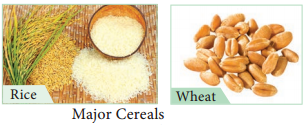
Wheat
Botanical name: Triticum aestivum
Origin and Area of cultivation
Earliest evidence for wheat cultivation comes from Fertile Crescent region. The common cultivated wheat, Triticum aestivum is cultivated for about 7, 500 years. Wheat is mostly cultivated in the North Indian states such as Uttar Pradesh, Punjab, Haryana, Rajasthan, Madhya Pradesh and Bihar.
Uses
Wheat is the staple food in Northern India. Wheat flour is suitable to make bread and other bakery products. Processed wheat flour, that has little fire, is called Maida which is used extensively in making parota, naan and bakery products. Malted wheat is a major raw material for producing alcoholic beverages and nutritive drinks.
Uses
Most of the corn produced is used as fodder than food. Corn syrup is used in the manufacture of infant foods. Corn is a raw material in the industrial production of alcohol and alcoholic beverages.
Millets (Siru Thniyangal)
The term millet is applied to a variety of very small seeds originally cultivated by ancient people in Africa and Asia. They are gluten free and have less glycemic index.
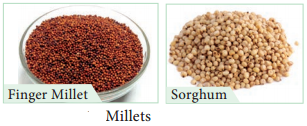
Finger Millet – Ragi
Botanical name: Eleusine coracana
Finger millet is the crop of early introduction from East Africa into India. Ragi is rich in calcium.
Uses
It is used as a staple food in many southern hilly regions of India. Ragi grains are made into porridge and gruel. Ragi malt is the popular nutrient drink. It is used as a source of fermented beverages.
Sorghum
Botanical name: Sorghum vulgare.
Sorghum is native to Africa. It is one of the major millets in the world and is rich in calcium and iron.
Uses
It is fed to poultry, birds, pigs and cattle and a source of fermented alcoholic beverage.
Minor Millets
Foxtail Millet
Botanical name: Setaria italica
This is one of the oldest millet used traditionally in India. Which is domesticated first in China about 6000 years. Rich in protein, carbohydrate, vitamin B and C, Potassium and Calcium.
Uses
It supports in strengthening of heart and improves eye sight. Thinai porridge is given to lactating mother.
Kodo Millet
Botanical name: Paspalum scrobiculatum
Kodo millet is originated from West Africa, which is rich in fire, protein and minerals.
Uses
Kodo millet is ground into flour and used to make pudding. Good diuretic and cures constipation. Helps to reduce obesity, blood sugar and blood pressure.
Pulses
The word Pulse is derived from the Latin words ‘puls’ or ‘pultis’ meaning “thick soup”. Pulses are the edible seeds that are harvested from the fruits of Fabaceae. They provide vital source of plant-based protein, vitamins and minerals for people around the globe.
Black gram
Botanical name: Vigna mungo
Origin and Area of cultivation
Black gram is native to India. Earliest archeobotanical evidences record the presence of black gram about 3, 500 years ago. It is cultivated as a rain fed crop in drier parts of India. India contributes to 80% of the global production of black gram. Important states growing black gram in India are Uttar Pradesh, Chattisgarh and Karnataka.
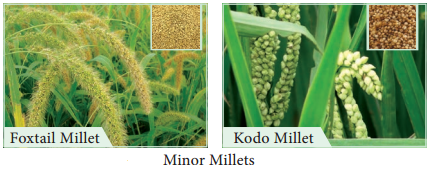
Uses
Black gram is eaten whole or split, boiled or roasted or ground into flour. Black gram batter is a major ingredients for the preparation of popular Southern Indian breakfast dishes. Split pulse is used in seasoning Indian curries.
Red gram / Pigeon pea
Botanical name: Cajanus cajan
Origin and Area of cultivation:
It is the only pulse native to Southern India. It is mainly grown in the states of Maharashtra, Andhra Pradesh, Madhya Pradesh, Karnataka and Gujarat.
Uses
Red gram is a major ingredient of sambar, a characteristic dish of Southern India. Roasted seeds are consumed either salted or unsalted as a popular snack. Young pods are cooked and consumed.
Green gram
Botanical name: Vigna radiata
Origin and Area of cultivation
Green gram is a native of India and the earliest archaeological evidences are found in the state of Maharashtra. It is cultivated in the states of Madhya Pradesh, Karnataka and Tamil Nadu.
Uses
It can be used as roasted cooked and sprouted pulse. Green gram is one of the ingredients of pongal, a popular breakfast dish in Tamil Nadu. Fried dehulled and broken or whole green gram is used as popular snack. The flur is traditionally used as a cosmetic, especially for the skin.
Vegetables
While walking through a market filled with fresh vegetables like stacks of lady’s finger, mountains of potatoes, pyramids of brinjal, tomatoes, cucurbits, we learn to choose the vegetables that is fresh, tender, ripe and those suit the family taste through experience and cultural practices. Why do we need to eat vegetables and what do they provide us?
Vegetables are the important part of healthy eating and provide many nutrients, including potassium, dietary fiber, folic acid and vitamins A, E and C. The nutrients in vegetables are vital for maintenance of our health.
Lady’s finger / Okra
Botanical name: Abelmoschus esculentus
Family: Malvaceae
Origin and Area of cultivation
Lady’s figer is a native of the Tropical Africa. Assam, Maharashtra and Gujarat are the important states where Lady’s finger is grown in abundance. Coimbatore, Dharmapuri and Vellore are the major cultivating regions of Tamil Nadu.
Uses
The fresh and green tender fruits are used as a vegetable. Often they are sliced and dehydrated to conserve them for later use. It has most important nutrients.
Fruits
Edible fruits are flashy structures with a pleasant aroma and flavours. Fruits are sources of many nutrients including potassium, dietary fiber, folic acid and vitamins.Depending on the climatic region in which fruit crops grow, they can be classified into temperate (apple, pear, plum) and tropical fruits (mango, jack, banana). In this chapter we will study an example of tropical fruit.
Mango (National fruit of India)
Botanical name: Mangifera indica
Family: Anacardiaceae
Origin and Area of cultivation
The mango is the native to Southern Asia, especially Burma and Eastern India. It is the National fruit of India. Major mango producing States are Andhra Pradesh, Bihar, Gujarat and Karnataka. Salem, Krishnagiri, Dharmapuri are the major mango producing districts of Tamil Nadu. Some of the major cultivars of mango in India are Alphonsa, Banganapalli, neelam and malgova.

Uses
Mango is the major table fruit of India, which is rich in beta carotenes. It is utilized in many ways, as dessert, canned, dried and preserves in Indian cuisine. Sour, unripe mangoes are used in chutneys, pickles, side dishes, or may be eaten raw with salt and chilli. Mango pulp is made into jelly. Aerated and non-aerated fruit juice is a popular soft drink.
Nuts
Nuts are simple dry fruits composed of a hard shell and an edible kernel. They are packed with a good source of healthy fats, fire, protein, vitamins, minerals and antioxidants.
Cashew nut
Botanical name: Anacardium occidentale
Family: Anacardiaceae
Origin and Area of cultivation
Cashew has originated in Brazil and made its way to India in the 16th century through Portuguese sailors. Cashew is grown in Kerala, Karnataka, Goa, Maharashtra, Tamil Nadu, and Orissa.
Uses
Cashews are commonly used for garnishing sweets or curries, or ground into a paste that forms a base of sauces for curries or some sweets. Roasted and raw kernels are used as snacks.
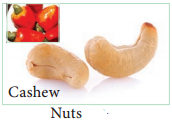
Sugars
We experienced sweetness while eating the stems of sugarcane, roots of sugar beet, fruits of apple and while drinking palmyra sap. This is due to the different proportions of sugars found in it. Sugar is the generic name for sweet tasting soluble carbohydrate, which are used in foods and beverages. Sugars found in sugarcane and palmyra make them ideal for efficient extraction to make commercial sugar.
Sugarcane
Botanical name: Saccharum offinarum
Family: Poaceae
Origin and Area of cultivation
The cultivated Saccharum officinarium has evolved by repeated back crossing of S.offinarum of New Guinea with wild S.spontaneum of India to improve the quality. All districts except Kanyakumari and Nilgiris of Tamil Nadu cultivate Sugarcane.
Uses
Sugar cane is the raw material for extracting white sugar. Sugarcane supports large number of industries like sugar mills producing refield sugars, distilleries producing liquor grade
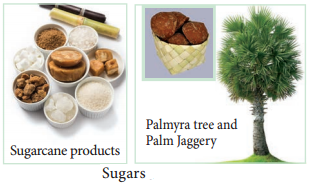
ethanol and millions of jaggery manufacturing units. Fresh sugarcane juice is a refreshing drink. Molasses is the raw material for the production of ethyl alcohol.
Palmyra (State tree of Tamil Nadu)
Botanical name: Borassus flabellifer
Family: Arecaceae
Origin and Area of cultivation
Palmyra is native to tropical regions of Africa, Asia and New Guinea. Palmyra grows all over Tamil Nadu, especially in coastal districts.
Uses
Exudate from influrescence axis is collected for preparing palm sugar. Influrescence is tapped for its sap which is used as health drink. Sap is processed to get palm jaggery or fermented to give toddy.
Endosperm is used as a refreshing summer food. Germinated seeds have an elongated embryo surrounded by fleshy scale leaf which is edible.
Oil Seeds
Why fried foods are tastier than boiled foods? There are two kinds of oils namely, essential oils and vegetable oils or fatty oils. The essential oils or volatile oils which possess aroma evaporate or volatilize in contact with air. Any organ of a plant may be the source of essential oil.
For example, flowers of Jasmine, fruits of orange and roots of ginger. The vegetable oils or non-volatile oils or fixed oils that do not evaporate. Whole seeds or endosperm form the sources of vegetable oils. Let us know about few oil seeds
Groundnut / Peanut
Botanical name: Arachis hypogaea
Family: Fabaceae
Origin and Area of Cultivation:
Groundnut is native of Brazil. Portuguese introduced groundnut into Africa. The Spanish took it to the South East Asia and India via Philippines. In India Gujarat, Andhra Pradesh and Rajasthan are top producers.
Uses
Nuts contain about 45% oil. The kernels are also rich sources of phosphorous and vitamins, particularly thiamine, riboflavin and niacin. It is premium cooking oil because it does not smoke. Lower grade oil is used in manufacture of soaps and lubricants.
Sesame / Gingelly
Botanical name: Sesamum indicum
Family: Pedaliaceae
Origin and Area of cultivation:
Sesamum indicum has originated from Africa. Sesame is cultivated as a dry land crop. West Bengal and Madhya Pradesh are the top producers in India during 2017-18. It is considered as a healthy oil in Southern Indian culture.
Uses
Sesame oil is used for mostly culinary purposes in India. Lower grades are used in manufacture of soaps, in paint industries, as a lubricant and as an illuminant. In India, the oil is the basis of most of the scented oils used in perfumes. Sesame seed snacks are popular throughout India.
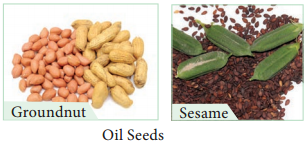
Beverages
How about a cup of coffe or tea? We always entertain our guests with this offer.
All non-alcoholic beverages contain alkaloids that stimulate central nervous system and also possess mild diuretic properties.
Coffee
Botanical name: Coffea arabica
Family: Rubiaceae
Why does a student or a driver prefer tea or coffee during night work?
Origin and Area of cultivation:
Coffea arabica is the prime source of commercial coffee which is native to the tropical Ethiopia An Indian Muslim saint, Baba Budan introduced coffee from Yemen to Mysore.Karnataka is the largest coffee producing state in India followed by Tamil Nadu and Kerala. Tamil Nadu is the largest consumer of coffee in India.

Uses
Drinking coffee in moderation provides the following health benefits:
Caffiene enhances release of acetylcholine in brain, which in turn enhances efficiency. It can lower the incidence of fatty liver diseases, cirrhosis and cancer. It may reduce the risk of type 2 diabetes.